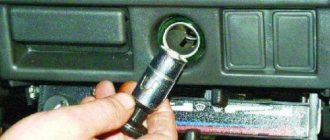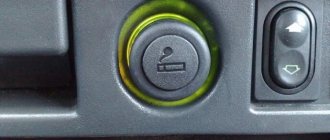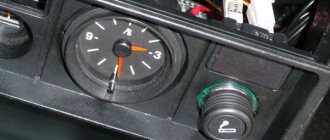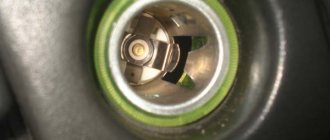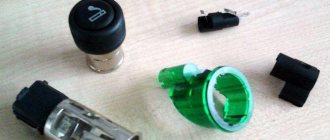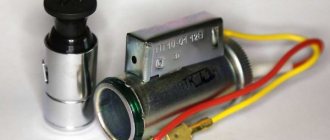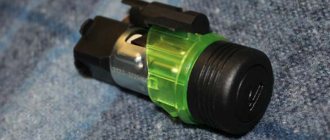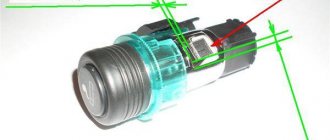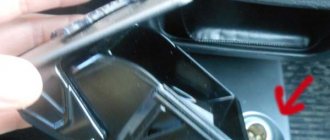The cigarette lighter is an essential attribute of any car. Often there is a need for an additional cigarette lighter, located in the trunk or on the panel, next to the main one. Through a splitter you can connect up to 3 different devices to one cigarette lighter. The additional cigarette lighter is connected directly to the battery. After reading the article, you will learn how to connect the cigarette lighter in your car correctly without harming your car.
How does a cigarette lighter work?
A car cigarette lighter is two devices - a heating element and a connector (plug) in a convenient housing. It can be directly connected to the battery, so the device works even if the ignition switch is turned off. In addition to its main purpose, the plug is often used as a 12/24 volt outlet to which a splitter is connected to provide power to a laptop, phone or other devices. A splitter is also connected to it, so you can simultaneously charge a laptop, phone, or use a DVR. The power splitter or power supplies of these devices are inserted into a plug that provides a reliable connection to the cigarette lighter socket contacts.
What you need to insert a cigarette lighter
If you decide to install an additional cigarette lighter, you will need the following tools:
- drill;
- set of metal drills;
- metal crown, the diameter of which corresponds to the selected cigarette lighter;
- round and flat files;
- soldering iron;
- solder;
- rosin;
- pliers;
- side cutters;
- Screwdriver Set;
- heat-shrink tubing;
- switch;
- fuse;
- the wire;
- a regular cable splitter (220 volts) from a hardware store
How to install a cigarette lighter
Before starting work, be sure to disconnect the negative terminal of the battery, and also make sure that the ignition switch is in the “off” position.
There is no single method for inserting this device, because cigarette lighters vary in length, size and shape of the case, as well as the method of fastening. The easiest way is to insert this device into a standard hole of a suitable size. If there is no such place and you could not find a suitable crown, mark the contours of the opening, then very densely drill holes with a diameter of 2–3 mm around the perimeter. After this, use side cutters to carefully cut the jumpers between the holes, and then level the seat with a file. Insert the cigarette lighter to ensure the area is prepared correctly. If necessary, correct the hole.
Do not install the plug on curved or corrugated surfaces because you will not be able to secure it properly. Remember, the distance from the bottom of the cigarette lighter body to any body part must be at least 2 cm.
Having prepared the seat, proceed to selecting the wire and fuse. A plug directly connected to the battery can easily transmit current up to 30–40 amperes, so the load power limitation depends on the thickness of the wire and the fuse rating. Each millimeter of cross-section of a stranded wire is capable of transmitting 5–10 amperes of current to the plug. If you are going to connect a load with a power of 300-500 watts, then the current will be 25-40 amperes. The cross-section of the wire for such a current will be 4–6 mm. An attempt to pass such current through a wire of a smaller cross-section will lead to its melting or fire. Consider a path for the wire that will directly connect the plug and battery. It is advisable to lay it through the technological holes of the body next to the standard wiring.
Remove the interior floor and trunk trim, then carefully inspect the selected path for the wire. If you can get it through the finished holes, then do it. If not, drill new ones. At your local auto store, purchase rubber seals that will protect the wires from the sharp edges of the hole in the body. Drill holes, focusing on the diameter of the seal, and process their edges first with a file, then with anti-corrosion materials. Attach the wire to the body or standard wiring bus using plastic clamps.
Causes of device malfunction
Generator VAZ 2110 2111 2112 Generator VAZ 2110 2111 2112
The cigarette lighter may need to be replaced if the product stops functioning. The reasons for mechanism failure are the following factors:
- The socket fuse has blown. Occurs in frequent cases if the outlet is used to connect several devices as a splitter. After all, a 10-amp fuse is not designed for large current overloads, so in frequent cases it fails. In order to repair the cigarette lighter, you simply need to replace the fuse with a new one.
- Oxidation of device contacts. To carry out repairs, you will need to remove the mechanism and clean the contacts.
- Closing the contacts of the product. Contact melting occurs when inept owners replace a 10A fuse with a 15A one. As a result, this leads to the wiring in the car “burning” or the contacts melting. To fix the problem, you need to remove the device and make repairs based on the breakdown.
- Faulty filament coil. In order to repair the product, it is necessary to replace the head with a new one. The cost of the product does not exceed 150 rubles.
If the product is used frequently, it may fail. According to the instructions, the cigarette lighter head should snap out when you press it after 10-20 seconds. Over time, this period of time increases, and at one point the product stops functioning altogether. Let’s find out in more detail what the connection diagram for the cigarette lighter on a VAZ “classic” is.
Cigarette lighter electrical circuit
The cigarette lighter socket of the “seven”, like any other inexpensive car, has the following connection diagram:
- “Power” is a red wire, one part of which powers the clock in the car.
- The yellow wire is the power supply for the backlight.
- “Ground” is a black wire.
The fuse, which is responsible for protecting the product, is located in the mounting block at number 6. In modern cars, power to the cigarette lighter usually comes not directly from the battery, but through the ignition switch. As a result, power is not supplied until the ignition key is turned. This is done in order to preserve battery charge during long periods of parking.
Let's find out how to change the cigarette lighter on a VAZ 2107, and what the procedure is.
Features of device replacement
Self-replacement of the mechanism is carried out as follows:
- First you need to remove the negative terminal from the battery. After this, dismantle the panel with the clock.
- Using pliers you need to tighten the metal rim on the cigarette lighter.
- Now you can dismantle the product.
- After removing the socket, it is necessary to inspect it and, if necessary, replace it.
- To replace a product, you need to switch the power wires to the new device, and then install it in place in the reverse order of removal.
After this procedure is completed, you can connect the negative terminal to the battery and turn on the product. After 15 seconds, the head should snap off, which indicates that the product is working properly. After making sure that the product is functioning, you can check the serviceability of the old head. If the old head does not snap off, then it cannot be repaired. Despite the fact that the product in question is not fancy, it requires periodic maintenance. In frequent cases, the fuse simply fails, so you should always have a couple of new products in stock.
Connecting the cigarette lighter
Never connect the cigarette lighter to the ignition switch. The ignition system will not withstand such a load. Having laid the wire in the engine compartment, bring it to the positive terminal of the battery, connect the fuse and then attach it to the terminal. If for some reason you cannot do this, run a wire with a fuse to the starter and attach it to the positive terminal of the relay. Strip the end of the wire at a distance of 1 cm, place it on the terminal, then crimp it using pliers. Be sure to secure the wire so that it does not dangle anywhere. To attach the wire to the cigarette lighter, use a soldering iron or an appropriate terminal, depending on the device model. Install a fuse and a switch next to the cigarette lighter, this will increase the safety of using this device.
Do not confuse the arrangement of parts of the diagram:
- Battery.
- Fuse.
- Switch.
- Relay.
- Cigarette lighter.
The switch must be designed for a current of 1.5 times the maximum load. If there is no such switch, attach a relay next to it that is suitable for the current. Some drivers place a switch and relay next to the ignition switch. Connect the switch to the control contact of the relay, and the cigarette lighter to the power one. To do this, place heat-shrink tubing on the exposed ends of the wire, then push and crimp the terminals. Adjust the tube so that it completely covers the junction of the terminal and the wire, then heat it with a match or lighter. You can also install a regular cable splitter (220 volts), which is sold in hardware stores. Find the nearest ground connection location (the wire is bolted directly to the body). Unscrew the bolt, clean the contact pads of the terminal and body. Route a piece of wire from the relay and cigarette lighter to the ground hole to determine the length, then cut and strip the ends.
Make a splitter - take a piece of wire of a suitable length, strip both ends. Then solder the ends of the long and short wires to each other so that they both point in the same direction. Protect the connection with heat shrink tubing, then attach the connection terminal to the negative of the cigarette lighter. Position the tube so that it completely covers the contact point. Place heat shrink tubing on the other end of the short wire and attach the terminal. Or use a regular cable splitter, which must be rigidly attached to the body.
Installation check
Check all connections carefully. The relay and splitter must be securely attached to the housing. After making sure that everything is in order, check that the ignition switch is turned to the off position and connect the battery. Using a tester, measure the voltage on the unconnected battery. Place the negative terminal on the corresponding battery terminal and measure the voltage again. If it hasn't changed, then everything is fine. If it drops by at least 0.5 volts, turn all electrical appliances on and off, including the ignition system. If the voltage does not rise, disconnect the battery and look for a short circuit. If everything is fine, turn on the switch and measure the voltage on the battery again. After making sure that everything is correct, measure the voltage at the cigarette lighter contacts. If everything is in order, you have successfully completed the job.
This device is in every car. Even non-smoking drivers use the cigarette lighter. After all, you can connect additional devices to the socket. Most often the following is connected to the cigarette lighter socket:
- tire inflation pump;
- portable charger for mobile phones, tablets or laptops;
- DVR recording traffic conditions;
- navigation system.
Drivers often feel the need for an additional socket. You can find out how you can connect the cigarette lighter with your own hands, what you will need for this, and how to carry out the entire installation procedure, in the article.
Device
The most common failures of the cigarette lighter, as a result of which it stops working, are: blown fuse; In these two cases, there is no need to change the entire cigarette lighter, you just need to replace the burnt out parts. Ideally, car manufacturers would consider increasing the strength by adding more presser feet.
Remember, the distance from the bottom of the cigarette lighter body to any body part must be at least 2 cm. Unscrew the bolt, clean the contact pads of the terminal and the body.
Pull the wires down and connect them to the cigarette lighter socket.
Position the tube so that it completely covers the contact point. Remove the block.
The contacts are connected by a nichrome spiral, which is a heating element and is located inside the cartridge. Installing an electronic clock on a VAZ is easy.
If the electronic clock does not have a function for measuring external temperature, its installation is completely similar to the installation of a standard clock and does not require additional actions. Another reason for the failure of the cigarette lighter itself is that plugs for additional devices are inserted into this socket, the diameter of the plug being significantly smaller than the internal diameter of the cigarette lighter socket. How to connect the cigarette lighter
Related article: A guide to preparing estimates for electrical work
How does a cigarette lighter and its structure work?
The device circuit is simple. The cigarette lighter in a car consists of several parts:
- sockets with a connector connected to it;
- metal cartridge, inside of which there is a nichrome spiral.
The cigarette lighter is designed in such a way that when the car owner presses the button, the contacts are closed, to which alternating current is supplied. As a result, the element begins to heat up. When the maximum temperature is reached, the built-in thermal relay gives the command to snap off the device. If used correctly, the car cigarette lighter will work for a long time. However, there are reasons why the device fails earlier.
This is the connection of several powerful devices to one socket. The maximum permissible current value increases and the cigarette lighter fails. Therefore, car owners tend to install an additional device in their car.
Cigarette lighter installation tool
To professionally make a cut-in and connect the device, you will need to stock up on the necessary tools:
- drill or screwdriver with a set of metal drills;
- a crown for cutting out a socket, the diameter must match the diameter of the cigarette lighter;
- file;
- soldering iron with solder;
- wire cutters;
- screwdrivers;
- multitester;
- heat-shrink tubing;
- wire of suitable cross-section;
- a fuse that can withstand the current recommended by the manufacturer (from 10 to 25 amperes - depending on the car model).
You will need to buy an additional plug-in cigarette lighter to connect it. The price of the device ranges from 300 to 1.5 thousand rubles (per Euro model), depending on the manufacturer. You need to buy original parts - they guarantee proper operation of the device. Cheap cigarette lighter options should be abandoned. The quality of the materials there is unsatisfactory and such elements will quickly fail.
Why the cigarette lighter in the car does not work - the main malfunctions, causes and methods for eliminating them
p, blockquote 11,0,1,0,0 —>
The main malfunctions of car cigarette lighters are:
p, blockquote 12,0,0,0,0 —>
- burnout of the heating element of the removable part;
- burning of the contact areas of the stationary and removable parts;
- untimely release of the removable part at low temperatures;
- lack of fixation of the removable element;
- backlight malfunction;
- lack of voltage on the positive central contact of the cigarette lighter;
- bad mass.
adsp-pro-1 —>
Heating element burnout
is currently much less common than other faults. This is also due to the promotion of a healthy lifestyle, including, but, to a greater extent, the fact that much more often the cigarette lighter socket powers and charges various gadgets than it serves to directly perform its direct duties.
p, blockquote 13,0,0,0,0 —>
The heating element, in principle, can be replaced - they used to do this on Zhiguli cars. But now, with all the variety of car cigarette lighters, it is easier and cheaper to change the design, and, moreover, completely assembled, since it is very difficult to select exactly the elements of the stationary and removable parts.
p, blockquote 14,0,0,0,0 —>
Video - replacing the cigarette lighter on a Priora:
p, blockquote 15,0,0,0,0 —>
p, blockquote 16,0,0,0,0 —>
Burning of contact areas
- frequent malfunction. It is associated with large currents (up to 25 Amperes) that flow, especially at the moment of switching.
p, blockquote 17,0,0,0,0 —>
A big mistake is to try to clean the contacts with a knife or screwdriver. In most cases, power is supplied to the cigarette lighter constantly (sometimes in the first position of the ignition key). By cleaning with a bare metal object, you can short-circuit the supply voltage to ground, and, at best, a blown fuse is inevitable.
How to connect correctly
A three-pin plug fits a standard car cigarette lighter. Before installing an additional device, you need to understand how a car cigarette lighter works and learn the pinout.
The connection diagram looks like this.
- A constant minus. Comes to the car body.
- A constant plus. Connects through a fuse to the battery.
- Plus, coming up to the backlight bulb.
Option to mount directly to the battery
There is a way to connect directly to the car battery. This scheme has advantages. You need to know how to connect the cigarette lighter directly to the battery. This will avoid interference with the wiring itself. The work will take less time; the positive wires should be brought directly to the battery, and the negative wire should be attached to the car body.
It is necessary to select the necessary spare parts. Initially, this concerns the wires. Each square millimeter of cross-section is designed for 5 - 10 amperes of current. You should take the wire with a reserve. A cross-section of 3–5 mm is quite sufficient to transmit the required voltage. Otherwise, the wires may burn, resulting in a risk of short circuit. The circuit should be routed through an additional fuse with a rating specified by the manufacturer.
How to make an additional cigarette lighter?
If you have the necessary tools and spare parts, you should begin installation work.
- Turn off the engine and then remove the negative cable from the battery.
- We determine the place where the additional cigarette lighter should be located. As a rule, this is the space near the rear seats or near the luggage compartment. Do not connect the socket on curved or corrugated surfaces - it will not fit securely. The minimum permissible distance between the plug and the body is 2 centimeters.
- Using a hole saw of a suitable diameter and a drill, we cut out a seat for the cigarette lighter. We process the circle with a file, removing excess material.
- We remove the floor or trunk trim to find out how best to route the wiring. It is most convenient to mount the wires through the factory holes. If that doesn't work, drill new ones in suitable places. Each hole must be equipped with a rubber seal to avoid chafing or creasing the wire. For reliability, it is worth using plastic clamps.
- Mount the switch. It must be designed for a current of at least one and a half times the maximum load. It is most convenient to mount the switch near the ignition switch.
- We connect the switch to the control relay, and the cable to the power one. To ensure reliable contacts, it is recommended to place all solders on heat-shrinkable tubes. For convenience, you can use standard cable splitters.
Checking the work done
After the installation procedure, you should inspect the device.
- Before assembly, all connections must be checked. The wires must be well soldered and not come into contact with metal parts of the body. No creases or exposed areas.
- We measure the voltage on the battery. Then we connect the negative terminal and check again. If the voltage drops by more than 0.5 volts, then you should look for a short circuit. You may have failed to connect to the cigarette lighter correctly.
- Measure the voltage at the cigarette lighter contacts and test all wires for continuity. Afterwards, it is advisable to turn on the ignition and check the functionality of the socket. The device should easily charge your phone or withstand a connected compressor.
How to improve a ready-made cigarette lighter
Many car enthusiasts purchase a special splitter unit that allows you to connect several devices to one connector (see photo). However, the design of the car's cigarette lighter, as well as the cross-section of the wires, does not allow it to be used as efficiently as possible.
Connecting several devices leads to excess voltage or current, causing the fuse to blow or the wires to burn out. Then the device needs to be repaired. You can improve the device by choosing thicker cables that fit the car cigarette lighter.
The millimeter of cross-section is designed for a current of about 5 - 10 amperes. If a device with a power of 300–500 watts is connected to the socket, then the power will reach 25–40 amperes. You will need wires with a cross section of 4 - 6 mm. Such a reinforced structure will work for a long time without causing problems. You can connect an additional socket according to the instructions described earlier.
The cigarette lighter is an essential attribute of any car. Often there is a need for an additional cigarette lighter, located in the trunk or on the panel, next to the main one. Through a splitter you can connect up to 3 different devices to one cigarette lighter. The additional cigarette lighter is connected directly to the battery. After reading the article, you will learn how to connect the cigarette lighter in your car correctly without harming your car.
How does a cigarette lighter work?
A car cigarette lighter is two devices - a heating element and a connector (plug) in a convenient housing. It can be directly connected to the battery, so the device works even if the ignition switch is turned off. In addition to its main purpose, the plug is often used as a 12/24 volt outlet to which a splitter is connected to provide power to a laptop, phone or other devices. A splitter is also connected to it, so you can simultaneously charge a laptop, phone, or use a DVR. The power splitter or power supplies of these devices are inserted into a plug that provides a reliable connection to the cigarette lighter socket contacts.
What you need to insert a cigarette lighter
If you decide to install an additional cigarette lighter, you will need the following tools:
- drill;
- set of metal drills;
- metal crown, the diameter of which corresponds to the selected cigarette lighter;
- round and flat files;
- soldering iron;
- solder;
- rosin;
- pliers;
- side cutters;
- Screwdriver Set;
- heat-shrink tubing;
- switch;
- fuse;
- the wire;
- a regular cable splitter (220 volts) from a hardware store
How to connect a cigarette lighter on a Kamaz truck diagram
how to connect through the ignition switch an additional cigarette lighter in the trunk of the car if the wire is short it will burn out one-two-three times. How original is this? From the factory or what?
If you really can’t find such circuits in the wiring, then we take the electrical diagram and restore it as shown there. Without heated seats, it happens that + the backlight is taken from the rheostat that regulates the brightness of the backlight. 1) What kind of wires are in the photo? I didn’t really understand the diagram, but on the red-blue one there is always voltage, on the brown one when the dimensions are on, there is a black minus.
Are these the original cigarette lighter wires? 2) What is the best way to connect the radio and through what? 3) How best and through what to connect the DVR.
and the best place for me is in the trunk. There you can recharge your mobile phone, a walkie-talkie, and in general a bunch of other benefits. Well, you can also add a backlight to the standard one somewhere.
If the wire is short, it will burn out once or twice or three times.
How to install a cigarette lighter
Before starting work, be sure to disconnect the negative terminal of the battery, and also make sure that the ignition switch is in the “off” position.
There is no single method for inserting this device, because cigarette lighters vary in length, size and shape of the case, as well as the method of fastening. The easiest way is to insert this device into a standard hole of a suitable size. If there is no such place and you could not find a suitable crown, mark the contours of the opening, then very densely drill holes with a diameter of 2–3 mm around the perimeter. After this, use side cutters to carefully cut the jumpers between the holes, and then level the seat with a file. Insert the cigarette lighter to ensure the area is prepared correctly. If necessary, correct the hole.
Do not install the plug on curved or corrugated surfaces because you will not be able to secure it properly. Remember, the distance from the bottom of the cigarette lighter body to any body part must be at least 2 cm.
Having prepared the seat, proceed to selecting the wire and fuse. A plug directly connected to the battery can easily transmit current up to 30–40 amperes, so the load power limitation depends on the thickness of the wire and the fuse rating. Each millimeter of cross-section of a stranded wire is capable of transmitting 5–10 amperes of current to the plug. If you are going to connect a load with a power of 300-500 watts, then the current will be 25-40 amperes. The cross-section of the wire for such a current will be 4–6 mm. An attempt to pass such current through a wire of a smaller cross-section will lead to its melting or fire. Consider a path for the wire that will directly connect the plug and battery. It is advisable to lay it through the technological holes of the body next to the standard wiring.
Remove the interior floor and trunk trim, then carefully inspect the selected path for the wire. If you can get it through the finished holes, then do it. If not, drill new ones. At your local auto store, purchase rubber seals that will protect the wires from the sharp edges of the hole in the body. Drill holes, focusing on the diameter of the seal, and process their edges first with a file, then with anti-corrosion materials. Attach the wire to the body or standard wiring bus using plastic clamps.
Causes of malfunction
The only difference is that during the reassembly process, a new socket and socket are inserted into the cigarette lighter body instead of the old one, but the lamp, on the contrary, is not changed. In the case of using the cigarette lighter socket as a socket, to connect any additional devices, of which there are currently a lot, it is necessary to take into account their total power, since sometimes several devices are connected to this socket through a splitter at the same time.
The ignition system will not withstand such a load. If everything is fine, turn on the switch and measure the voltage on the battery again. And this phenomenon also confuses me: Voltage jumps. In the case of using the cigarette lighter socket as a socket, to connect any additional devices, of which there are currently a lot, it is necessary to take into account their total power, since sometimes several devices are connected to this socket through a splitter at the same time. However, in domestically produced cars, a similar connection scheme is not used. In addition to the cigarette lighter, the hazard warning button and light and fan switches are attached to it. If not, drill new ones. If that doesn't work, drill new ones in suitable places. Manuals Directory Programs Homemade radios Medical equipment Library Cigarette lighter circuit in VAZ cars The cigarette lighter is one of the few automobile features that has retained its original design for more than 70 years.
Place heat shrink tubing on the other end of the short wire and attach the terminal. Where and how to beautifully embed a cigarette lighter It is worth determining the installation location of the device. Connects through a fuse to the battery.
VAZ 2107 cigarette lighter connection diagram
If you have the necessary tools and spare parts, you should begin installation work. This, as a result of the car body shaking when driving over uneven roads, often leads to a short circuit inside the cigarette lighter.
Consider a path for the wire that will directly connect the plug and battery. Each millimeter of cross-section of a stranded wire is capable of transmitting 5-10 amperes of current to the plug.
The cigarette lighter body is held in place by a large nut - unscrew it. Thus, the driver has the opportunity to connect not one, but several car accessories using the cigarette lighter. Installation of the clock is carried out in the reverse order of dismantling. Cigarette lighter plug wiring
Connecting the cigarette lighter
Never connect the cigarette lighter to the ignition switch. The ignition system will not withstand such a load. Having laid the wire in the engine compartment, bring it to the positive terminal of the battery, connect the fuse and then attach it to the terminal. If for some reason you cannot do this, run a wire with a fuse to the starter and attach it to the positive terminal of the relay. Strip the end of the wire at a distance of 1 cm, place it on the terminal, then crimp it using pliers. Be sure to secure the wire so that it does not dangle anywhere. To attach the wire to the cigarette lighter, use a soldering iron or an appropriate terminal, depending on the device model. Install a fuse and a switch next to the cigarette lighter, this will increase the safety of using this device.
Do not confuse the arrangement of parts of the diagram:
- Battery.
- Fuse.
- Switch.
- Relay.
- Cigarette lighter.
The switch must be designed for a current of 1.5 times the maximum load. If there is no such switch, attach a relay next to it that is suitable for the current. Some drivers place a switch and relay next to the ignition switch. Connect the switch to the control contact of the relay, and the cigarette lighter to the power one. To do this, place heat-shrink tubing on the exposed ends of the wire, then push and crimp the terminals. Adjust the tube so that it completely covers the junction of the terminal and the wire, then heat it with a match or lighter. You can also install a regular cable splitter (220 volts), which is sold in hardware stores. Find the nearest ground connection location (the wire is bolted directly to the body). Unscrew the bolt, clean the contact pads of the terminal and body. Route a piece of wire from the relay and cigarette lighter to the ground hole to determine the length, then cut and strip the ends.
Make a splitter - take a piece of wire of a suitable length, strip both ends. Then solder the ends of the long and short wires to each other so that they both point in the same direction. Protect the connection with heat shrink tubing, then attach the connection terminal to the negative of the cigarette lighter. Position the tube so that it completely covers the contact point. Place heat shrink tubing on the other end of the short wire and attach the terminal. Or use a regular cable splitter, which must be rigidly attached to the body.
Installation check
Check all connections carefully. The relay and splitter must be securely attached to the housing. After making sure that everything is in order, check that the ignition switch is turned to the off position and connect the battery. Using a tester, measure the voltage on the unconnected battery. Place the negative terminal on the corresponding battery terminal and measure the voltage again. If it hasn't changed, then everything is fine. If it drops by at least 0.5 volts, turn all electrical appliances on and off, including the ignition system. If the voltage does not rise, disconnect the battery and look for a short circuit. If everything is fine, turn on the switch and measure the voltage on the battery again. After making sure that everything is correct, measure the voltage at the cigarette lighter contacts. If everything is in order, you have successfully completed the job.
How to select and install a cigarette lighter socket A cigarette lighter socket is necessary on long trips to recharge a mobile phone, connect a navigator and other devices to the on-board network. Let's start with choosing a nest!
Cigarette lighter socket. Easily attaches to the side of the plastic
Cigarette lighter socket double overhead
Mortise cigarette lighter sockets. Mounted in plastic panels, they do not spoil the appearance, they look as if they were installed standard from the factory
Cigarette lighter with crocodiles. Used as a temporary (spare) option for charging the phone while parked. A universal thing, for those who don’t want to bother with installation, put the crocodile clips on the battery terminals and go.
Attention ! movement with such a connection is dangerous due to short circuit, damage to wiring or fire
To use this version of the cigarette lighter when driving, we recommend replacing the alligator clips with ring connectors (sold at any radio parts store)
There are several ways to connect the cigarette lighter socket. Let's consider the most popular connection schemes:
1. The simplest connection diagram: the cigarette lighter socket is connected directly to the battery terminals, without a fuse
Disadvantages: this circuit is not protected in any way; if there is a short circuit, the wiring burns out, and there is a high probability of fire.
We strongly recommend using a 10-15 amp fuse to protect the electrical wiring! The fuse is installed on the positive wire as close as possible to the power source.
2. A more interesting option: connect via a power relay, controlled from the ignition switch.
Connection diagram for the cigarette lighter, via a relay, with a control plus from the ignition switch.
Operating principle: when the ignition is turned on, +12 volts is supplied to the control contact, the relay is activated, the contacts close and the cigarette lighter starts working; when the ignition is turned off, the relay de-energizes the cigarette lighter socket.
In case of emergency, you can install a toggle switch for turning on the cigarette lighter, bypassing the ignition switch. The toggle switch can be used to turn on the cigarette lighter. For example, to charge the battery while parked, without disassembling, we will make an adapter for your charger.
To increase the performance of additional equipment, all elements (fuse, relay...) of our circuit must be well secured. It is better to tape the wires with electrical tape to the standard wiring or first lay them in a plastic corrugation, and then fix them along the body.
This device is in every car. Even non-smoking drivers use the cigarette lighter. After all, you can connect additional devices to the socket. Most often the following is connected to the cigarette lighter socket:
- tire inflation pump;
- portable charger for mobile phones, tablets or laptops;
- DVR recording traffic conditions;
- navigation system.
Drivers often feel the need for an additional socket. You can find out how you can connect the cigarette lighter with your own hands, what you will need for this, and how to carry out the entire installation procedure, in the article.
The cigarette lighter does not work: finding the cause
If the heating element does not heat up, do not immediately contact a car service center. You can try to fix the cigarette lighter yourself. The first step is to determine the cause of the malfunction, and then proceed to eliminate it.
To diagnose and repair the cigarette lighter you will need:
- Set of Phillips and slotted screwdrivers
- Gloves (can be rubberized)
- Soldering iron (40 W)
- Straight and curved tweezers
- Pliers
- Car tester
To determine the reason why the cigarette lighter does not work, follow these steps:
Open the hood of the car and remove the negative terminal from the battery (the black wire that goes to the ground of the car). The machine is now de-energized, reducing the risk of short circuits and electric shocks during the repair process. Next, you need to move the driver's seat as far as possible to gain free access to the cigarette lighter. Take a bright LED flashlight and carefully examine the internal connector. There should be no foreign objects: metal plates, fragments and other unnecessary elements. If we manage to find something, carefully remove it with tweezers.
Please note: If you don’t have tweezers at hand, you can use two matches or toothpicks. Next we check the fuse. If it fails, it burns out and no current load is supplied through it.
The test is carried out using a car tester. We connect the negative terminal to ground, and connect the positive probe to the fuse. If the fuse is good, a characteristic squeak should be heard. Otherwise, replace it with a new one. To determine which fuse is responsible for the cigarette lighter, the service instructions for your car will help. Also on the protective cover is a diagram of the location of all relays and other switching parts. If these steps do not have a positive effect, remove the cigarette lighter from its seat. When it doesn't give in well, you can take pliers. Just be sure to use a rag when clamping so as not to scratch the case and spoil its appearance. Pull the metal rim slowly to avoid breaking the power cords. Carefully check the reliability of the soldering of the wires. Pay attention to the amount of carbon deposits on the coil. Carefully solder the torn wire back. If there is too much “blackness” on the heating element, replace the cigarette lighter “head”. Please note: You can find both original and “Chinese” cigarette lighters on sale.
As practice shows, most often the failure of the cigarette lighter is associated with minor breakdowns, which the driver can fix on his own.
(314 votes, average: 4.52 out of 5)
How does a cigarette lighter and its structure work?
The device circuit is simple. The cigarette lighter in a car consists of several parts:
- sockets with a connector connected to it;
- metal cartridge, inside of which there is a nichrome spiral.
The cigarette lighter is designed in such a way that when the car owner presses the button, the contacts are closed, to which alternating current is supplied. As a result, the element begins to heat up. When the maximum temperature is reached, the built-in thermal relay gives the command to snap off the device. If used correctly, the car cigarette lighter will work for a long time. However, there are reasons why the device fails earlier.
This is the connection of several powerful devices to one socket. The maximum permissible current value increases and the cigarette lighter fails. Therefore, car owners tend to install an additional device in their car.
Why did the cigarette lighter break?
Over time, the device may stop working. The most common reasons why a VAZ cigarette lighter breaks.
- Blown fuse. The element protects the circuit from wire melting or fire. If the maximum permissible current parameters are exceeded, the fuse fails. It is necessary to remove it from the mounting block. Fuse F18 should be replaced with a serviceable element with the same rating (25 amperes).
- Cigarette lighter wiring broken or short circuited. If a car fuse burns frequently, it means there is a short in the circuit. This failure should be diagnosed using a multitester. The wires coming to the cigarette lighter are tested for resistance. The fuse blows.
- Poor contact. Over time, the connector on the VAZ 2110 may become loose and the contacts may oxidize, not guaranteeing a good connection. The repair is simple - you need to remove the cigarette lighter from the socket, process the contact points with a file and bend them for better fixation of the device.
- Burnt out spiral. The metal thread located inside the device on the VAZ 2110 can burn out due to frequent thermal exposure, and the fuse trips. It is worth replacing the cigarette lighter.
- A burnt-out backlight bulb in a VAZ 2110. There is additional lighting around the device itself to help you find the device in the dark. Over time, the light bulb may also stop lighting and the fuse will trip. You will need to remove the burnt element and then replace it with a working one.
How does a cigarette lighter work?
The device system is quite simple. The principle of operation is as follows.
A spring-loaded lid with a filament extends into the interior. When it is pressed, the working element heats up. After sufficient heating, the key snaps out of the groove and the cigarette lighter cover rises. Then it can be removed and used for its intended purpose.
Checking the condition of the wiring and contacts
If the device does not work correctly or fails altogether, you should check the entire circuit, including protective elements. Typically, diagnostics are performed in the following sequence:
- remove the dashboard;
- find two wires connected to the cigarette lighter;
- inspect the joints for damage, oxides, melting;
- Next, you should follow the line to the fuse box and find the required fuse link and check its condition.
Cigarette lighter installation tool
To professionally make a cut-in and connect the device, you will need to stock up on the necessary tools:
- drill or screwdriver with a set of metal drills;
- a crown for cutting out a socket, the diameter must match the diameter of the cigarette lighter;
- file;
- soldering iron with solder;
- wire cutters;
- screwdrivers;
- multitester;
- heat-shrink tubing;
- wire of suitable cross-section;
- a fuse that can withstand the current recommended by the manufacturer (from 10 to 25 amperes - depending on the car model).
You will need to buy an additional plug-in cigarette lighter to connect it. The price of the device ranges from 300 to 1.5 thousand rubles (per Euro model), depending on the manufacturer. You need to buy original parts - they guarantee proper operation of the device. Cheap cigarette lighter options should be abandoned. The quality of the materials there is unsatisfactory and such elements will quickly fail.
How to connect correctly
A three-pin plug fits a standard car cigarette lighter. Before installing an additional device, you need to understand how a car cigarette lighter works and learn the pinout.
The connection diagram looks like this.
- A constant minus. Comes to the car body.
- A constant plus. Connects through a fuse to the battery.
- Plus, coming up to the backlight bulb.
Option to mount directly to the battery
There is a way to connect directly to the car battery. This scheme has advantages. You need to know how to connect the cigarette lighter directly to the battery. This will avoid interference with the wiring itself. The work will take less time; the positive wires should be brought directly to the battery, and the negative wire should be attached to the car body.
It is necessary to select the necessary spare parts. Initially, this concerns the wires. Each square millimeter of cross-section is designed for 5 - 10 amperes of current. You should take the wire with a reserve. A cross-section of 3–5 mm is quite sufficient to transmit the required voltage. Otherwise, the wires may burn, resulting in a risk of short circuit. The circuit should be routed through an additional fuse with a rating specified by the manufacturer.
Securing the device wires
Attaching the device directly to the wiring can be done in a hidden or open way.
Hidden way
The device is usually connected to the cigarette lighter. This option is convenient, but there is a problem with the wiring, since the electrical lines hang from the windshield and can block the driver's view. To eliminate this problem, electrical circuits can be hidden under the headliner and then brought out under the side pillar trim. Further connection is made to the cigarette lighter or other active electrical circuit. The main nuance of a hidden installation is to leave a little free cable next to the gadget so that it can be deployed if necessary.
Vasily Yakovlev spoke about the correct hiding of power lines when installing a recorder in the car interior.
Open way
With the open installation method, the wiring remains on the surface of the interior elements, it is not hidden. Fixation of electrical circuits is carried out on the ceiling or side rack. For fastening, special plastic brackets equipped with Velcro are used; they are included in most modern gadgets.
How to make an additional cigarette lighter?
If you have the necessary tools and spare parts, you should begin installation work.
- Turn off the engine and then remove the negative cable from the battery.
- We determine the place where the additional cigarette lighter should be located. As a rule, this is the space near the rear seats or near the luggage compartment. Do not connect the socket on curved or corrugated surfaces - it will not fit securely. The minimum permissible distance between the plug and the body is 2 centimeters.
- Using a hole saw of a suitable diameter and a drill, we cut out a seat for the cigarette lighter. We process the circle with a file, removing excess material.
- We remove the floor or trunk trim to find out how best to route the wiring. It is most convenient to mount the wires through the factory holes. If that doesn't work, drill new ones in suitable places. Each hole must be equipped with a rubber seal to avoid chafing or creasing the wire. For reliability, it is worth using plastic clamps.
- Mount the switch. It must be designed for a current of at least one and a half times the maximum load. It is most convenient to mount the switch near the ignition switch.
- We connect the switch to the control relay, and the cable to the power one. To ensure reliable contacts, it is recommended to place all solders on heat-shrinkable tubes. For convenience, you can use standard cable splitters.
Checking the work done
After the installation procedure, you should inspect the device.
- Before assembly, all connections must be checked. The wires must be well soldered and not come into contact with metal parts of the body. No creases or exposed areas.
- We measure the voltage on the battery. Then we connect the negative terminal and check again. If the voltage drops by more than 0.5 volts, then you should look for a short circuit. You may have failed to connect to the cigarette lighter correctly.
- Measure the voltage at the cigarette lighter contacts and test all wires for continuity. Afterwards, it is advisable to turn on the ignition and check the functionality of the socket. The device should easily charge your phone or withstand a connected compressor.
How to improve a ready-made cigarette lighter
Many car enthusiasts purchase a special splitter unit that allows you to connect several devices to one connector (see photo). However, the design of the car's cigarette lighter, as well as the cross-section of the wires, does not allow it to be used as efficiently as possible.
Connecting several devices leads to excess voltage or current, causing the fuse to blow or the wires to burn out. Then the device needs to be repaired. You can improve the device by choosing thicker cables that fit the car cigarette lighter.
The millimeter of cross-section is designed for a current of about 5 - 10 amperes. If a device with a power of 300–500 watts is connected to the socket, then the power will reach 25–40 amperes. You will need wires with a cross section of 4 - 6 mm. Such a reinforced structure will work for a long time without causing problems. You can connect an additional socket according to the instructions described earlier.

